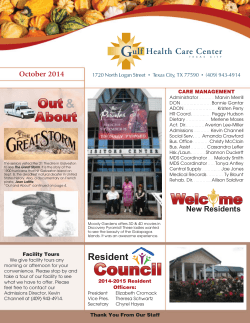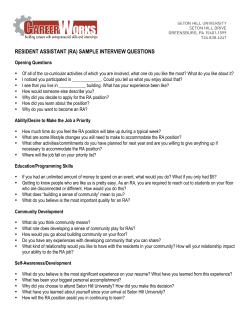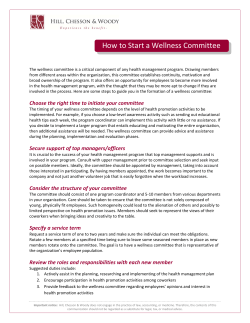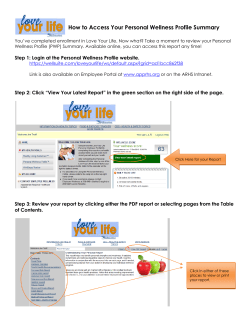
Quality of Life Issues in Student Family Housing Redevelopment Committee Fall 2014
Quality of Life Issues in Student Family Housing Student Family Housing Redevelopment Committee Fall 2014 Quality of Life Issues in Student Family Housing Can look at the issues from multiple perspectives: ! Psychology • Maslow’s Hierarchy of Needs ! Health • Eight Dimensions of Wellness ! Institutional Mission • Defining Effective Educational Practices Research Project • Principles of Community from the Carnegie Foundation for the Advancement of Teaching ! Professional Best Practices • Council for the Advancement of Standards in Higher Education Maslow’s Hierarchy of Needs Eight Dimensions of Wellness1 Wellness is not the absence of disease, illness or stress, but the presence of purpose in life, active involvement in satisfying work and play, joyful relationships, a healthy body and living environment, and happiness.2 Emotional Coping effectively with life and creating satisfying relationships Environmental Good health by occupying pleasant, stimulating environments that support well-being Financial Satisfaction with current and future financial situations Intellectual Recognizing creative abilities and finding ways to expand knowledge and skills Occupational Personal satisfaction and enrichment from one’s work Physical Recognizing the need for physical activity, healthy foods and sleep Social Developing a sense of connection, belonging, and a well-developed support system Spiritual Expanding our sense of purpose and meaning in life 1 Dunn, H.L. (1961). High-Level Wellness, Beatty Press: Arlington, VA. 2 Adapted from Swarbrick, M. (2006). A Wellness Approach. Psychiatric Rehabilitation Journal, 29(4), 311–314. Best Practices as determined by the Defining Effective Educational Practices Research Project time and energy best predictor devoted to of educationally purposeful activities learning and personal development ENGAGEMENT From Kuh, G. D., Kinzie, J., Schuh, J. H., Whitt, E. J. & Associates (2005). Student success in college: Creating conditions that matter. San Francisco: Jossey-Bass. Best Practices as determined by the Defining Effective Educational Practices Research Project Effective educational practices of institutions that perform well on student engagement and graduation rates: 1. High academic challenge 2. Active and collaborative learning 3. Interaction with faculty 4. Enriching educational experiences – internships, service, study abroad, co-curricular activities, culminating senior experience 5. Supportive campus environment: a. help students succeed academically, cope with nonacademic responsibilities, thrive socially b. promote good relations between students and peers, staff and faculty From Kuh, G. D., Kinzie, J., Schuh, J. H., Whitt, E. J. & Associates (2005). Student success in college: Creating conditions that matter. San Francisco: Jossey-Bass. Principles of Community In 1990, The Carnegie Foundation for the Advancement of Teaching initiated a study of community, entitled Campus Life: In Search of Community. Ernest Boyer developed six principles that defined the kind of community every college and university should strive to be. Purposeful Faculty and students share academic goals and work together to strengthen teaching and learning. Open Freedom of expression is uncompromisingly protected and civility is powerfully affirmed. Just The sacredness of the person is honored and diversity is aggressively pursued. Disciplined Individuals accept their obligations to the group and well-defined governance procedures guide behavior for the common good. Caring The well-being of each member is sensitively supported and service to others is encouraged. Celebrative The heritage of the institution is remembered and rituals affirming both tradition and change are widely shared. Council for the Advancement of Standards in Higher Education CAS is a consortium of professional associations that develops and promulgates standards and guidelines. • 44 sets of functional area standards for higher education programs and services • standards provide a means for assessing program and service effectiveness • Graduate and Professional Student Programs and Services • Housing and Residential Life Programs • International Student Programs and Services • Parent and Family Programs http://www.cas.edu Council for the Advancement of Standards in Higher Education Examples of CAS Standards for Housing and Residential Life Programs • create an environment that encourages safety, community engagement, academic achievement and personal development • nurture environments that are welcoming to and bring together persons of diverse backgrounds • involve students in programming, policy development, and self-governance • initiate collaborative interactions with stakeholders who have legitimate concerns and interests • address characteristics and needs of diverse populations when establishing and implementing policies and procedures • apply effective practices to educational and administrative processes • be responsive to needs of individuals, diverse and special populations • instill strong norms of acceptable behavior regarding respecting others' rights - security, quiet, etc. • conduct regular evaluations of resident satisfaction with programs and services, resident relations and sense of community, safety and security, ability to study in apartment, interactions with staff, responsiveness of administration to resident suggestions and concerns Community A group of people sharing a common purpose, are interdependent for the fulfillment of certain needs, live in close proximity, interact on a regular basis, share in defining expectations for all members of the group assume responsibility for meeting these expectations, and are respectful and considerate of the individuality of others. From Conneely, R. (1992). The development of community. In V. Gore (Ed.), ACUHO-I family housing monograph (pp. 29-35). Columbus, OH: ACUHO-I. Community Development The process of shaping the environment, or building on the experiences and needs of members, both individually and collectively, of creating the attitudes and developing the skills necessary to progress toward the realization of those conditions which make up the community. From Conneely, R. (1992). The development of community. In V. Gore (Ed.), ACUHO-I family housing monograph (pp. 29-35). Columbus, OH: ACUHO-I. Sense of Community That “feeling” of cooperation and commitment to the group welfare, of a willingness to communicate openly, and of responsibility to and for others as well as one’s self.1 Not just a place where interaction occurs, but a spirit of connection and commitment that sustains relationships and purpose.2 1 Conneely, R. (1992). The development of community. In V. Gore (Ed.), ACUHO-I family housing monograph (pp. 29-35). Columbus, OH: ACUHO-I. 2 Komives, S. R., Lucas, N., & McMahon, T. R. (1998). Exploring leadership: For college students who want to make a difference. San Francisco: Jossey-Bass Publishers. Developing a List of Quality of Life Issues in Student Family Housing By combining the concepts from the various sources, we can determine categories for quality of life issues and begin to develop a list of these issues. We will go back to our notes from open forums as well as discussions with residents and other constituents to continue adding to this list. Environmental • • • • temperature control, ventilation natural light privacy aesthetically pleasing landscaping & buildings Family & Functional Needs • • • • • • • • • • • adequate closet & storage space kitchen facilities laundry parking spaces & policies (including distance to apt) bathroom facilities (e.g., bathtub) ability to use patios & balconies to suit family needs mail plenty of outlets a variety of apartment options (studios, 1 & 2 bed, 3 bed?) 1st & 2nd floors for residents with children access for community members with disabilities Developing a List of Quality of Life Issues in Student Family Housing Safety & Security • secure locks • ability to lock windows open a few inches • relatively safe for children to play outside Financial • assistance in accessing financial support programs (certified enrollment counselors – CalFresh, WIC, Medi-Cal, Covered California, Housing Choice Vouchers / Section 8) • spousal employment • UC Davis childcare reimbursement funds • affordable rent Coping with Nonacademic Issues • child care, school, after-school activities, elder care • information on community support programs Academic Success • sufficiently quiet (e.g., insulation between walls) • study space • wi-fi Developing a List of Quality of Life Issues in Student Family Housing Social Relationships & Community Development • • • • • • • • • community space with a kitchen and play area outdoor recreational space residents involved in development of policies & procedures apartments laid out to increase interaction community events to develop relationships & enjoy others behavioral norms well-defined and effective response protocols for noncompliance social media & email lists (e.g., babysitting & child care) orientation & welcome for new residents structure in place to appreciate staff & community members Diversity • eligibility policies (definition of family, gender-neutral, etc.) • policies and procedures impact on international students/families • community programming that affirms a diversity of cultures and traditions Administration • • • • responsive to residents’ needs (satisfaction surveys, follow-up on concerns) structure in place to solicit feedback & follow-up on issues maintenance protocols positive relationships with most residents
© Copyright 2025












